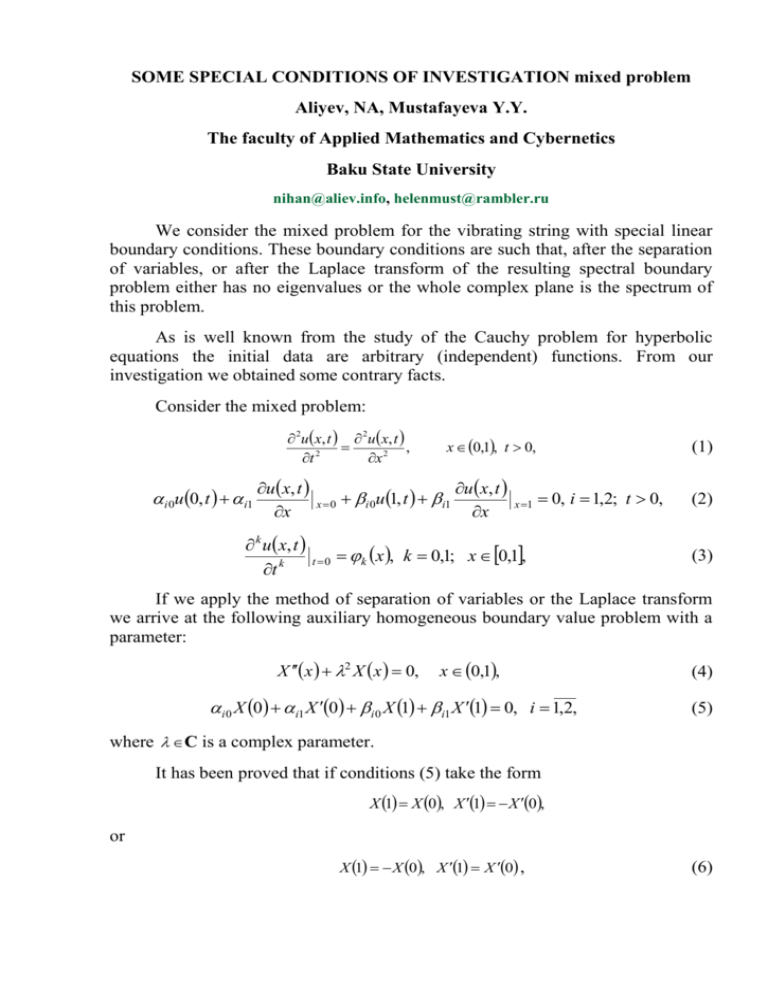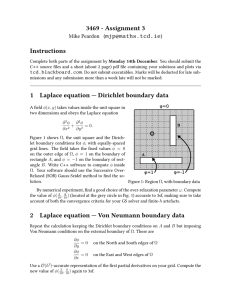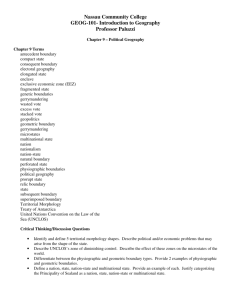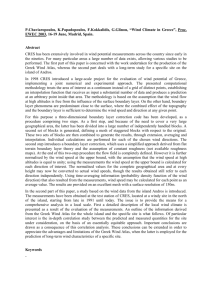Nihan Aliyev, Yelena Mustafayeva – Some Special Conditions of
advertisement

SOME SPECIAL CONDITIONS OF INVESTIGATION mixed problem Aliyev, NA, Mustafayeva Y.Y. The faculty of Applied Mathematics and Cybernetics Baku State University nihan@aliev.info, helenmust@rambler.ru We consider the mixed problem for the vibrating string with special linear boundary conditions. These boundary conditions are such that, after the separation of variables, or after the Laplace transform of the resulting spectral boundary problem either has no eigenvalues or the whole complex plane is the spectrum of this problem. As is well known from the study of the Cauchy problem for hyperbolic equations the initial data are arbitrary (independent) functions. From our investigation we obtained some contrary facts. Consider the mixed problem: 2u x, t 2u x, t , t 2 x 2 i 0u 0, t i1 u x, t x k ux, t t k x 0 t 0 x 0,1, t 0, i 0u 1, t i1 u x, t x x 1 (1) 0, i 1,2; t 0, k x , k 0,1; x 0,1, (2) (3) If we apply the method of separation of variables or the Laplace transform we arrive at the following auxiliary homogeneous boundary value problem with a parameter: X x 2 X x 0, x 0,1, i 0 X 0 i1 X 0 i 0 X 1 i1 X 1 0, i 1,2, (4) (5) where C is a complex parameter. It has been proved that if conditions (5) take the form X 1 X 0, X 1 X 0, or X 1 X 0, X 1 X 0 , (6) then holds true the following Theorem 1. If the entire complex plane is the spectrum for the auxiliary problem (4), (6) with a complex parameter, then for the existence of the solution of the mixed problem (1)-(3)) the initial data are not independent (arbitrarily given) 1 functions. Both 0 x and 1 x should be given on one of the intervals [0, ] or 2 1 [ ,1] and be continued as odd or even functions. 2 If the boundary conditions (5) take the form X 1 X 0, X 1 X ' 0, (7) or, correspondingly, the boundary conditions (2) take the form u (0, t ) u (1, t ), u (1, t ) u (0, t ) , x x (8) where is an arbitrary constant, 1 , then holds the following Theorem 2. If the auxiliary (spectral) problem (4), (5) does not have the spectrum, i.e., hold true boundary condition (7) (or (8)), for the existence of solutions of the mixed problem (1)-(3) the initial data are not arbitrary functions on (0,1), i.e. they are dependent, so that it is sufficient to give arbitrarily 0 x and 1 1 1 x on the interval [0, ] and define them on [ ,1] by means of the relationships 2 2 1 1 1 1 1 1 1 t 0 1 t , t [ ,1], , 2 2 2 1 t 1 1 1 1 1 1 1 t 0 1 t , t [ ,1] . 2 2 2 0 t The resulting pathology on the study of solutions of a mixed problem for a hyperbolic equation leads to the fact that the mixed problem may exist only in the case when the initial data are not arbitrary, and there is some connection between them. This connection is established using the method of characteristics.











